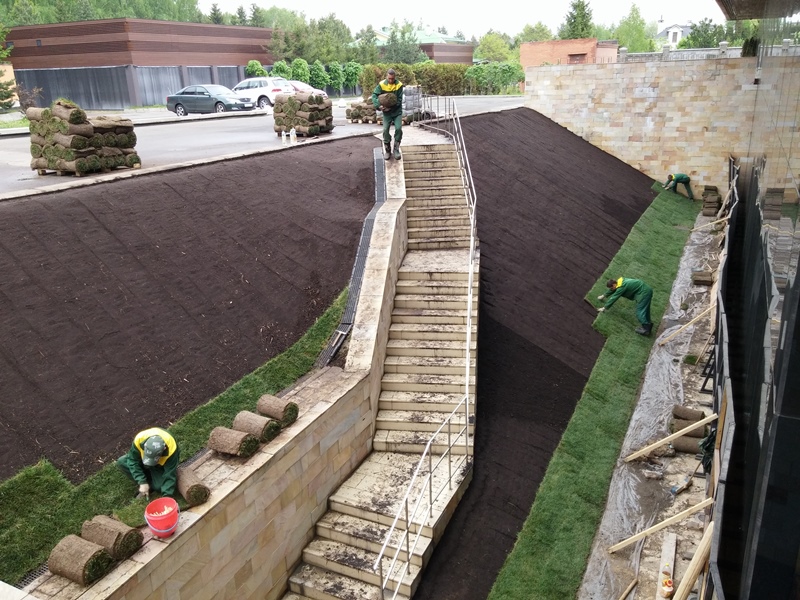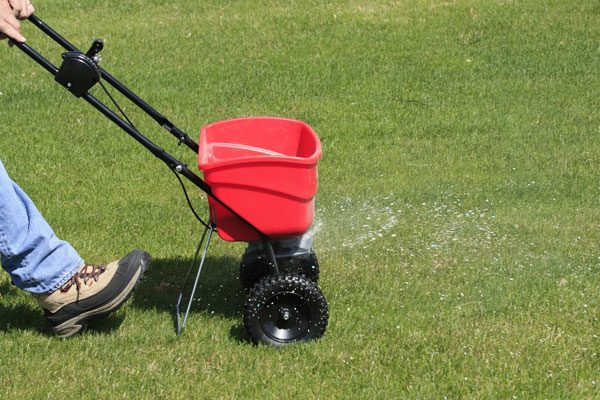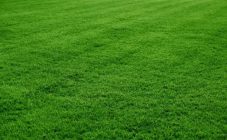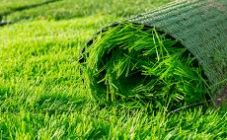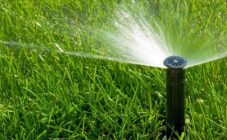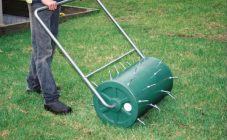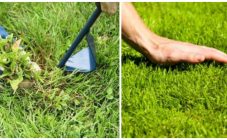Content:
A beautiful green lawn in front of a European-style house is a rolling lawn. Caring for him and laying lawn grass have a number of features.
What is a roll lawn
There are the following categories of rolling lawns:
- Standard. Grown over 2 years. Used bluegrass seeds. The color is dark emerald. Has resistance to drought, frost resistance, you can walk, but not play sports. Planted in open sunny areas where there is no shade. It is inexpensive, does not require much effort in the care.
- Universal. In addition to bluegrass, fescue seeds are sown. The color is more saturated. The structure is more homogeneous and denser than the e standard. The lawn survives frosts well, is not washed away by melt water, and can withstand drought. If the site is in partial shade, the grass does not stop growing, it burns out less.
- Sports. The root system of the herbage is very strong. Blades of grass are easily restored after crushing. The lawn is resistant to frost, drought and shade. The lawn remains bright green for most of the year. It is necessary to mow several times per season, and each time the height is left about 2 cm.
- Premium. Usually sown with meadow bluegrass. Differs in dark green color. Very dense structure, you need to look after regularly. The grass is thin. It winters well, but does not tolerate prolonged drought very well. Can be spread over almost any substrate. The life span is 2 years. It is used for lining elite landscapes.
The standard roll lawn construction includes layers:
- Grass. The height of this layer ranges from 4-7 cm. Plants such as bluegrass, reegrass, and fescue can be planted. Reygras grows faster than others.
- Felt. The thickness of the layer is 0.5-1 cm. To reduce the cost, felt is sometimes replaced with burlap. Not all manufacturers use this layer, some achieve roll density due to the dense weave of the roots.
- Priming. This includes the root system and some soil. The total height of the layer is 1.5 cm, the survival rate of the lawn depends on its quality.
Laying the lawn in rolls
How difficult it will be to lay the lawn depends on which category the owner of the site has chosen.
Preparing a place for a lawn
In no case is the lawn area prepared after the purchase of rolls. The preparatory activities will take a lot of time and effort, so they are planned and carried out in advance. The rules are:
- All rolls are spread immediately after purchase and delivery. They don't wait a single day, so the site is being prepared as a whole.
- The entire area must be cleared of debris and stones. Dig up the soil, picking the roots of perennial weeds.
- If the lawn is located in a low place, and the soil is clay, then you need to take care of drainage. For example, lay a layer of sand and provide a natural slope for water to drain into a specially made groove around the perimeter of the lawn.
For lawns in all areas, drainage is paramount. The scope of work to ensure the runoff of rain and melt water will be as follows:
- Remove a layer of surface soil 40 cm thick, fold it to the side.
- The resulting recess is covered with gravel to a height of 10 cm, and then a layer of sand of the same thickness.
- A sand and gravel pad is tamped.
- The previously removed soil is poured from above, leveling the site under one level with the edges.
- Spread mineral fertilizers over the surface and at the same time loosen the soil with a rake.
- Ram the site with a board or roller. On well-tamped ground, the leg does not fall through.
Laying roll lawn: step by step instructions
Purchased rolls of grass are laid in rows, and it is important not to allow distortions, since it is difficult to fix them. They start from one edge and move gradually to the opposite. Already laid paths are not stepped on. If you can't do without stepping, then they put a board and walk on it.
All rolls are spread so that there are no gaps, creases and overlaps between the edges. Each track needs to be smoothly leveled like a carpet. Only in this case the root system of the grass will immediately start growing. If the edges of the rolls protrude beyond the border of the designated area, then they are cut off with a knife or bayonet shovel. A layer of chopped grass mulch is poured along the perimeter.
The already laid lawn is rolled with a roller, which serves to spread the grass and better grip the edges of the bales.
If the lawn itself has taken root and started to grow, then after a week you can perform the first haircut. In large areas, use a lawn mower for this. If the lawn is small, then they take scissors for cutting. Subsequent haircuts are performed each time the grass grows 6 cm or more.
How to lay roll lawn on sand
Rolls of grass can be laid on a sandy area, but for this you will first have to fill in fertile soil. Additionally, long-acting fertilizers are applied. The sand will provide excellent drainage, but will not give the grass roots any nutrients, it is pointless to plant anything in it. And fertilizers added to the sand will wash out very quickly. That is why you cannot do without soil. Otherwise, the method of laying a roll lawn on sand is no different from the usual one.
How to lay a lawn on a slope
If an area with a large natural slope is allocated for the lawn, then preliminary laying of a special lawn or geogrid will be required. Such gratings are made from polyethylene or from plastic waste, which is characterized by high strength.
The geogrid is a bulk plastic lattice in the form of a honeycomb structure. Used polyethylene tapes 1.5 mm thick. Welded technology is used to fasten the cells. The ready-made frame is ideal for reinforcing a wide group of free-flowing fillers, for example, sand, soil, crushed stone, etc. Geogrids are used in road construction, as well as for arranging lawns on sloping sites. The grate effectively resists shear due to gravity and precipitation.
On sale there are geogrids in black and green. Individual modules are fastened to each other with special connecting latches. The result is an arbitrarily large homogeneous space, ready for dumping fertile soil and spreading lawn rolls.
The standard size of one module is 60 × 40 cm, and the height is 5 cm. The strength of the modules is such that you can walk on them, as well as ride a car or a bicycle.
Then it remains only to spread the rolls or sow the seeds. In the future, the lawn will require the same care as any other: regular watering, fertilization, mowing as the grass grows. The slope after completion of work will be reliably strengthened and protected from erosion by rain and melt water.
Care after styling
Proper care of your lawn will guarantee its blooming appearance for many years.
Rules for watering the lawn after laying
The first watering is designed not only to moisten the grass, but to shed the soil under it to a depth of 20 cm. You will need a hose connected to a pump and a water supply system or a well. A sprinkler or spray nozzle is put on the end of the hose; it is undesirable to pour water with a stream. Subsequent watering can be as abundant or less. Depends on weather conditions.
First haircut after styling
Each cut should cut the grass no more than a third of its height. For an ordinary lawn, the optimal lawn height is considered to be up to 6 cm. The first time the mowing is performed 7-10 days after the roll lawn is laid. Leave blades of grass in the range of 6-8 cm. Re-trimming can be shorter.
Top dressing of the lawn
Mineral dressings are made several times a season. Fertilizers of various types are applied. Potassium supplements are important throughout the growing season, since it is potassium that the grass needs for active growth and root formation. Nitrogen is added twice a summer - in early June and in mid-July. Superphosphate is added every 3 months - in spring, summer and autumn.
To make the lawn more decorative, accidentally grown weeds are removed, and aeration is carried out - they walk on the grass in special shoes with long spikes to provide oxygen access to the roots. These manipulations will have to be performed not so often, but the result is worth the effort.
Helpful hints
For those who first decided to purchase a roll lawn and lay it themselves, the following tips will be useful:
- Do not buy rolls for future use. They are always spread out on the day of delivery, otherwise the grass will simply dry out.
- If, for some reason, the rolls could not be packed on the day of delivery, care should be taken to create optimal conditions for them. They are folded in the shade and covered with foil, after sprinkling with water.
- Everyone can lay the rolls with their own hands, especially when it comes to lawns of the standard or universal categories. The key to success is accuracy and efficiency.
- It is possible to make rolls on your own, but it will cost more than just buying ready-made ones. Growing up is a laborious and costly process.
- If laying is required in an area of irregular shape or around a tree trunk, a rose bush, then pruning is performed with special scissors or a bayonet shovel. Large cuttings can be useful, but small ones do not take root well.
- The optimal cutting direction is across the rolls or diagonally. A repeated haircut must be carried out at an angle to the previous one.
- The last haircut is done about a week before the first freeze.
- You cannot reanimate the old lawn. You can only remove the rolls and lay new ones or you will need to plant the grass in the ground.
A lawn in rolls is a beautiful solution for a personal plot. It is undemanding to care for, and it looks excellent all year round. It is not surprising that its popularity is growing, and there are more and more new products from manufacturers every year.


